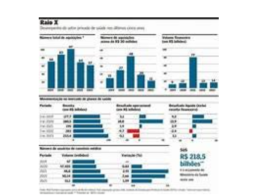the
health transformation
foundation
Joaquim Cardoso MSc
31 de Janeiro de 2024
What is the message
The healthcare sector’s traditional recession-proof reputation is being challenged by a combination of economic factors, shifting patient preferences, and rising costs, necessitating strategic adaptations by health systems to weather the storm.
Key takeaways
Past recessions:
During past recessions, the healthcare sector remained relatively immune to economic downswings .
Healthcare is Not Immune to Economic Downturns:
Unlike past recessions where healthcare remained relatively immune to economic downturns, the current landscape is different due to a combination of factors — (1) a sweeping labor shortage and (2) lower patient volumes have been added to the mix.
Financial Challenges for Health Systems:
While payers and some for-profit hospital chains have been able to generate healthy incomes, many smaller health systems are facing financial losses due to high costs and declining volumes.
The assumption that healthcare spending remains stable regardless of economic conditions is being called into question, particularly with the rise of high deductible plans leading some individuals to forgo medical care.
Shift Towards Outpatient Care:
The pandemic has accelerated the movement towards outpatient care, with retail clinics experiencing significant growth in claims volume. This shift has a direct impact on hospital finances as health systems heavily reliant on fee-for-service care face declines in patient volume.
Financial Strain on Hospitals:
Rising costs for supplies, drugs, and labor are exacerbating the financial woes of hospitals. Many are being forced to make tough decisions such as shutting down service lines and laying off workers.
Differences Between For-Profit and Nonprofit Health Systems:
For-profit health systems, while often financially successful, may prioritize shareholder expectations over community health and charity care. Some for-profit systems are even selectively admitting patients based on insurance payments.
Nonprofit systems, while also facing financial challenges, may place a greater emphasis on community outreach and charitable care.
Examples and Statistics
Shift Towards Outpatient Care: Retail clinic claims volumes have increased by 200% in the past five years, outpacing growth in claims for urgent care centers, emergency departments, and physician practices.
Financial Strain on Hospitals: From 2019 to 2022, hospitals saw significant increases in supply expenses per patient (18.5%), drug expenses per patient (19.7%), and labor costs (20.8%). Contract labor expenses specifically rose by 257.9% during the same period.
Impact on Employment: Becker’s Hospital Review reported that as of August 17, 80 different hospitals and health systems had laid off staff. Examples of hospitals eliminating hundreds of jobs include Jefferson Health and Allina Health.
Differences Between For-Profit and Nonprofit Systems: For-profit health systems may prioritize shareholder expectations over community health and charity care. In contrast, nonprofit systems may place a greater emphasis on community outreach and charitable care.
Strategies for Success:
Success Factors for Health Systems:
Establishing strongholds in outpatient areas, including investing in outpatient service lines and long-term care markets, could be crucial for the success of health systems amidst financial pressures.
Successful health systems are those with strongholds in outpatient areas, including investments in outpatient service lines and the long-term care market. These strategies help create access points and direct care more appropriately.
DEEP DIVE

Debunking Healthcare’s Recession-Proof Reputation
MedCityNews
By KATIE ADAMS
Aug 31, 2023
During past recessions, the healthcare sector remained relatively immune to economic downswings — but things are different now that a sweeping labor shortage and lower patient volumes have been added to the mix.
For example, payers and some for-profit hospital chains have been able to generate a healthy income, but many smaller health systems are suffering financial losses as they continue to battle high costs and declining volumes.
U.S. inflation rates may have reached a 40-year high last year, but this wasn’t the first time hospitals faced a highly inflationary environment. During past recessions, the healthcare sector remained relatively immune to economic downswings — but things are different now that a sweeping labor shortage and lower patient volumes have been added to the mix.
Dips in utilization lead to financial trouble
There is a “critical assumption” that people will always need healthcare services regardless of what the economic climate is like, and that this means the sector will witness less volatility in consumers’ spending levels due to economic conditions, Springer pointed out. However, it may time to reconsider the assumption.
“I think we have to call that logic into question a little bit, as deductibles have increased significantly,” she declared.
“People have to make a decision between buying gas or going to the doctor because they’ve got a high deductible plan,” she said.
For example, retail clinic claims volumes have shot up by 200% in the past five years. Claims growth for these clinics, which are usually located in stores like , and , have greatly outpaced growth in claims for urgent care centers, emergency departments and physician practices.
“The shift towards outpatient care was happening well before the pandemic, but the pandemic accelerated that movement. People are staying at home and working from home more often, so they may not want to go to the hospital — they may want to go to the CVS or Walgreens just right around the corner,” Swanson explained. And that choice has a direct link to hospital finances.
Because health systems derive so much of their revenue from fee-for-service care, decreases in patient volume are expected to continue to hurt their finances for the foreseeable future, Swanson said. However, payers benefit from declining utilization — low patient volumes means they are paying for fewer hospital stays.
Payers have been more resilient partly due to decreased utilization and partly because they don’t have to bear the costs of expensive labor and equipment like providers do.
Health insurers have remained profitable in the past few years, and a good handful raked in more than $1 billion in profits in the second quarter of this year — including UnitedHealthcare, Elevance Health, Centene, CVS Health and Cigna.
Not so recession-proof after all
As hospitals battle the effects of lower utilization, their financial woes are being exacerbated by rising costs for supplies, drugs, and most importantly, labor.
Hospitals’ supply expenses per patient increased by 18.5% from 2019 to 2022, and their drug expenses per patient rose by 19.7% during the same period, according to the American Hospital Association . As for labor costs, these rose by 20.8%. When looking solely at contract labor expenses, costs shot up a whopping 257.9% from 2019 to 2022.
With declining patient-driven revenue, most hospitals are batting rising costs and struggling to offset them. This has forced many to make tough business decisions, such as shutting down service lines and laying off workers.
A running list of hospital layoffs published by Becker’s Hospital Review shows that 80 different hospitals and health systems have laid off staff this year, as of its last update on August 17. Some recent examples of hospitals that are eliminating hundreds of jobs include , Jefferson Health and Allina Health .
How to weather the storm
Not all health systems are in the red — publicly-traded, for-profit systems have actually been doing quite well this year. For example, HCA Healthcare , the country’s largest for-profit hospital chain, a net income of $1.19 billion for the second quarter of this year. The second-largest for-profit health system, Tenet Healthcare , posted a net income of $123 million during the same period.
As for-profit companies, these health systems face pressure from their shareholders, Wheeler pointed out. Because of this, they don’t focus on advancing community health as much as nonprofit systems do — meaning for-profit hospitals don’t engage in the same level of charity care or community outreach.
“In the for-profit world, you have pressure from the expectations on the street and from your shareholders. In the nonprofit world, I think there’s more of a balance with their mission, as well as their charitable lens on the community. This is not to say that the for-profits don’t [provide charity care], but I don’t think they have as great an emphasis on it,” Wheeler said.
This type of for-profit thinking was evidenced last month by Steve Filton — the CFO of for-profit health system Universal Health Services (UHS) — on a second quarter earnings call.
“We’ve been going to our lowest payers and either demanding increases from them or canceling those contracts that we view to be inadequate and simply admitting patients whose insurance will pay us more, again, in an environment where we can only treat a limited number of patients. We can be more selective about who we treat and the fairness of what we think we’re being paid,” he said during the call.
However, it’s not just the for-profit systems that are figuring out ways to overcome hospitals’ bleak financial situation — some large non-profit systems are doing okay too. For example, Kaiser Permanente posted $741 million in operating income for the second quarter, and Mayo Clinic reported almost $300 million .
Going forward, the health systems that will be successful will be the ones that establish strongholds in outpatient areas, Swanson declared.
“Systems that have more substantial outpatient footprints are outperforming those systems that do not. Systems with their own medical groups and surgery centers are outperforming those that don’t have that.
And systems that have their own health plans tend to outperform those that don’t. Much of this is due to the ability to create access points and direct care more appropriately,” he explained.
Moving to make more investments in outpatient service lines and the long-term care market won’t be easy for hospitals that are facing severe financial pressure, but it could be what separates successful health systems from not-so-successful ones.
Originally published at https://medcitynews.com on August 31, 2023.











